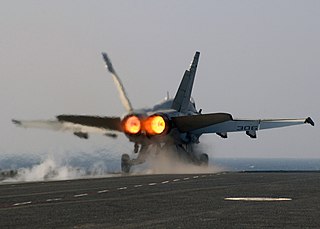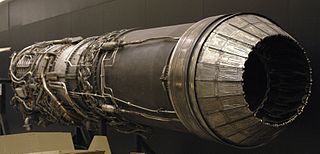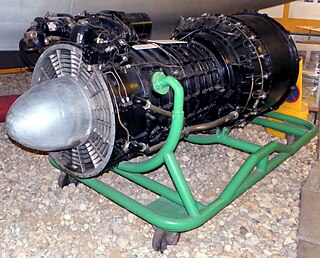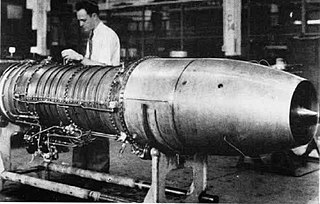Related Research Articles

A jet engine is a type of reaction engine discharging a fast-moving jet that generates thrust by jet propulsion. While this broad definition can include rocket, water jet, and hybrid propulsion, the term jet engine typically refers to an internal combustion airbreathing jet engine such as a turbojet, turbofan, ramjet, or pulse jet. In general, jet engines are internal combustion engines.

The turbofan or fanjet is a type of airbreathing jet engine that is widely used in aircraft propulsion. The word "turbofan" is a portmanteau of "turbine" and "fan": the turbo portion refers to a gas turbine engine which achieves mechanical energy from combustion, and the fan, a ducted fan that uses the mechanical energy from the gas turbine to force air rearwards. Thus, whereas all the air taken in by a turbojet passes through the combustion chamber and turbines, in a turbofan some of that air bypasses these components. A turbofan thus can be thought of as a turbojet being used to drive a ducted fan, with both of these contributing to the thrust.

The turbojet is an airbreathing jet engine, typically used in aircraft. It consists of a gas turbine with a propelling nozzle. The gas turbine has an air inlet which includes inlet guide vanes, a compressor, a combustion chamber, and a turbine. The compressed air from the compressor is heated by burning fuel in the combustion chamber and then allowed to expand through the turbine. The turbine exhaust is then expanded in the propelling nozzle where it is accelerated to high speed to provide thrust. Two engineers, Frank Whittle in the United Kingdom and Hans von Ohain in Germany, developed the concept independently into practical engines during the late 1930s.

An afterburner is an additional combustion component used on some jet engines, mostly those on military supersonic aircraft. Its purpose is to increase thrust, usually for supersonic flight, takeoff, and combat. The afterburning process injects additional fuel into a combustor in the jet pipe behind the turbine, "reheating" the exhaust gas. Afterburning significantly increases thrust as an alternative to using a bigger engine with its attendant weight penalty, but at the cost of increased fuel consumption which limits its use to short periods. This aircraft application of reheat contrasts with the meaning and implementation of reheat applicable to gas turbines driving electrical generators and which reduces fuel consumption.

The Rolls-Royce Olympus was the world's second two-spool axial-flow turbojet aircraft engine design, first run in May 1950 and preceded only by the Pratt & Whitney J57, first-run in January 1950. It is best known as the powerplant of the Avro Vulcan and later models in the Concorde SST.

The General Electric J79 is an axial-flow turbojet engine built for use in a variety of fighter and bomber aircraft and a supersonic cruise missile. The J79 was produced by General Electric Aircraft Engines in the United States, and under license by several other companies worldwide. Among its major uses was the F-104 Starfighter, B-58 Hustler, F-4 Phantom II, A-5 Vigilante and IAI Kfir.

The Pratt & Whitney J75 is an axial-flow turbojet engine first flown in 1955. A two-spool design in the 17,000 lbf (76 kN) thrust class, the J75 was essentially the bigger brother of the Pratt & Whitney J57 (JT3C). It was known in civilian service as the JT4A, and in a variety of stationary roles as the GG4 and FT4.

The Metropolitan-Vickers F.2 is an early turbojet engine and the first British design to be based on an axial-flow compressor. It was an extremely advanced design for the era, using a nine-stage axial compressor, annular combustor, and a two-stage turbine.

The Williams F107 is a small turbofan engine made by Williams International. The F107 was designed to propel cruise missiles. It has been used as the powerplant for the AGM-86 ALCM, and BGM-109 Tomahawk, as well as the experimental Williams X-Jet flying platform.

The SNECMA M53 is an afterburning turbofan engine developed for the Dassault Mirage 2000 fighter by Snecma. The engine is in service with different air forces, including the latest Mirage 2000-5 and 2000-9 multirole fighters.

The CFE738 is a small turbofan engine aimed at the business/commuter jet market manufactured by the CFE Company, and is used on the Dassault Falcon 2000.

The General Electric YJ93 turbojet engine was designed as the powerplant for both the North American XB-70 Valkyrie bomber and the North American XF-108 Rapier interceptor. The YJ93 was a single-shaft axial-flow turbojet with a variable-stator compressor and a fully variable convergent/divergent exhaust nozzle. The maximum sea-level thrust was 28,800 lbf (128 kN).

The Westinghouse J30, initially known as the Westinghouse 19XB, was a turbojet engine developed by Westinghouse Electric Corporation. It was the first American-designed turbojet to run, and only the second axial-flow turbojet to run outside Germany.

The Kuznetsov NK-25 is a turbofan aircraft engine used in the Tupolev Tu-22M strategic bomber. It can equal the NK-321 engine as one of the most powerful supersonic engines in service today. It is rated at 245 kN (55,000 lbf) thrust. The three shaft engine we call the NK-25 was designed in the years 1972–1974. It is made by the Soviet Kuznetsov Design Bureau.

The Fairchild J44 was a small turbojet developed in the 1940s by the Fairchild Engine Division.
The Flader J55, also known as the 124 within the company, was a small turbojet engine notable for its use of a supersonic axial-flow compressor. Development started at Fredric Flader Inc. in 1947, with the first examples being delivered in 1949. However, these delivered far lower power than predicted. Improved models followed in early 1952 that met the performance requirements, but demonstrated very poor reliability. When small engines from other companies became available, the J55 project was cancelled in 1952.
An airbreathing jet engine is a jet engine that ejects a propelling (reaction) jet of hot exhaust gases after first taking in atmospheric air, followed by compression, heating and expansion back to atmospheric pressure through a nozzle. Alternatively the reaction jet may include a cold jet of ducted bypass air which has been compressed by a fan before returning to atmospheric pressure through an additional nozzle. These engines are gas turbine engines. Engines using only ram for the compression process, and no turbomachinery, are the ramjet and pulsejet.
The Packard XJ41 was a turbojet aircraft engine developed by the Packard in the mid-1940s.
The Turbomeca Aspin was a small French turbofan engine produced by Turbomeca in the early 1950s. This geared turbofan design was the first turbofan to fly, powering the Fouga Gemeaux test-bed aircraft on 2 January 1952.
The Daimler-Benz DB 007,, was an early German jet engine design stemming from design work carried out by Karl Leist from 1939. This was a complex design featuring contra-rotating stages and a bypass fan, making it one of the earliest turbofan designs to be produced. The end result of the design work was built as the DB 007 and began testing on a test-bed on 27 May 1943. Due to the expected low performance, complexity and the good results achieved by much simpler designs, work was halted on the DB 007 in May 1944 by order of the RLM.
References
- Neal Robert J., Master Motor Builders, Aero-Marine History Publishing Co. (2000) ISBN 978-0964748316
- NASM Holdings, National Air and Space Museum, Washington, DC